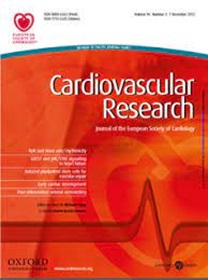Rbm20 antisense oligonucleotides alleviate diastolic dysfunction in a mouse model of cardiometabolic heart failure (HFpEF).
IF 13.3
1区 医学
Q1 CARDIAC & CARDIOVASCULAR SYSTEMS
引用次数: 0
Abstract
AIMS Heart failure with preserved ejection fraction (HFpEF) is prevalent, deadly, and difficult to treat. Risk factors such as obesity and hypertension contribute to cardiac inflammation, metabolic defects, and pathological remodelling that impair ventricular filling in diastole. Titin based stiffness is a main determinant of diastolic function and can be adjusted by the splicing regulator RNA binding motif protein 20 (RBM20). Inhibition of RBM20 using antisense oligonucleotides (ASOs) induces expression of compliant titin isoforms, which reduce stiffness. However, dose finding and documenting utility in primarily cardiometabolic disease remains challenging. METHODS AND RESULTS Here, we optimized RBM20-ASO dosing in a HFpEF mouse model that closely mimics human disease, characterized by metabolic syndrome and comorbidities, but without primary defects in titin or RBM20. Partial inhibition of RBM20 (∼50%) selectively increased compliant titin isoforms, improving diastolic function while preserving systolic performance. This intervention reduced left ventricular stiffness, enhanced relaxation, and mitigated cardiac hypertrophy, despite ongoing systemic comorbidities. CONCLUSION Our findings demonstrate that targeting titin stiffness with Rbm20-ASOs can serve as an alternative or adjunctive therapeutic strategy for HFpEF to restore cardiac function and prevent further organ damage. The approach may offer benefits even in the presence of phenotypic heterogeneity and unresolved systemic comorbidities.Rbm20反义寡核苷酸减轻心代谢性心力衰竭(HFpEF)小鼠模型舒张功能障碍。
心脏衰竭伴保留射血分数(HFpEF)是一种普遍、致命且难以治疗的疾病。肥胖和高血压等危险因素可导致心脏炎症、代谢缺陷和病理重构,从而损害舒张期心室充盈。基于Titin的硬度是舒张功能的主要决定因素,可以通过剪接调节剂RNA结合基序蛋白20 (RBM20)进行调节。使用反义寡核苷酸(ASOs)抑制RBM20诱导柔顺性titin亚型的表达,从而降低硬度。然而,剂量发现和记录在主要心脏代谢疾病中的效用仍然具有挑战性。方法与结果:我们优化了RBM20- aso在模拟人类疾病的HFpEF小鼠模型中的剂量,该模型以代谢综合征和合并症为特征,但没有titin或RBM20的原发性缺陷。RBM20的部分抑制(~ 50%)选择性地增加了顺应的titin亚型,在保持收缩性能的同时改善了舒张功能。这种干预降低了左心室僵硬,增强了舒张,减轻了心脏肥厚,尽管存在系统性合并症。结论Rbm20-ASOs靶向titin僵硬可以作为HFpEF的替代或辅助治疗策略,以恢复心功能并防止进一步的器官损伤。即使在存在表型异质性和未解决的系统性合并症的情况下,该方法也可能提供益处。
本文章由计算机程序翻译,如有差异,请以英文原文为准。
求助全文
约1分钟内获得全文
求助全文
来源期刊

Cardiovascular Research
医学-心血管系统
CiteScore
21.50
自引率
3.70%
发文量
547
审稿时长
1 months
期刊介绍:
Cardiovascular Research
Journal Overview:
International journal of the European Society of Cardiology
Focuses on basic and translational research in cardiology and cardiovascular biology
Aims to enhance insight into cardiovascular disease mechanisms and innovation prospects
Submission Criteria:
Welcomes papers covering molecular, sub-cellular, cellular, organ, and organism levels
Accepts clinical proof-of-concept and translational studies
Manuscripts expected to provide significant contribution to cardiovascular biology and diseases
 求助内容:
求助内容: 应助结果提醒方式:
应助结果提醒方式:


